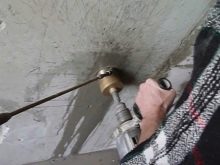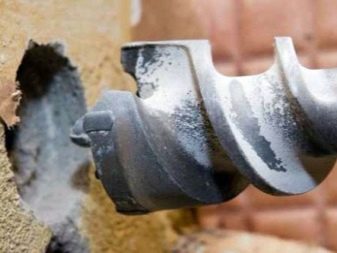Drills for concrete for a drill: structural features and application

One of the most common misconceptions among non-professional craftsmen is the fact that, in their opinion, surfaces made of a material such as concrete can be easily drilled with the most ordinary cutters for metal or even wood. They seriously believe that the same drill can be easily applied to any surface.
In fact, when working with concrete walls, you will need a special drill bit for the drill. Choosing the wrong product, you will ruin it forever, and you can easily break an expensive drilling device.

Features of the structure of the drill
A drill is a type of cutting tool designed for drilling various holes. A concrete drill is a special tool required for drilling bricks, fully cured concrete and any of its derivatives, as well as stone and stone-like materials. Drills for concrete differ from other types in special soldering over their entire surface, it is they who allow the drill to become as strong as possible. They also allow him to keep all his quality characteristics much longer.
Drills for concrete have certain visual differences, which will allow you not to make a mistake when choosing them in the store.
- The tips of products for drilling concrete have a slightly blunt end and a fairly strong soldering from Pobedit.
- Mills for concrete work most often have a specific whitish color, drills for metal coatings are distinguished by a black color, for wood - a light one.
- The tip, when compared to the rod, will be slightly larger.


A concrete milling cutter consists of the following parts and is made of the following materials:
- body (rod) - most often made of high-speed steel;
- cutting element - it is produced from carbide steel;
- tungsten and cobalt (VK);
- titanium and tungsten, as well as cobalt (TC);
- titanium and tantalum, as well as tungsten and cobalt (TTK).
- hard solder - it combines the body and the carbide itself.
The cutting element (so-called soldering) is produced from the most commonly used alloy of tungsten and cobalt. This soldering is marked as VK8. The most common name for all hard alloys for this kind of soldering is win. It is for this reason that the name "drill with a win" can often be found.

Which ones to choose?
It all depends on the type of device with which you will use the existing drills.
- Cutters for conventional drills. The shank will be in the form of a simple cylinder or polyhedron. The drills are suitable for working with bricks or foam blocks. A drill with a high power is selected for the drilling process.
- Rotary hammer cutters are usually more solid in size. You will definitely find the SDS max mark on the drill body. Products of this kind are needed for drilling the most durable surfaces - reinforced concrete, for example.



You may not be able to drill a wall of concrete with an ordinary home drill. If you are not able to do this, just take another tool, for example, a hammer drill, because it has significant power and excellent impact force in any drilling. The hammer drill is often referred to as a concrete drill by many craftsmen. There are 3 types of this popular tool:
- auger - used to create the deepest and widest holes possible without any problems;
- spiral - ideal for medium-sized holes;
- shallow - used in order to get small holes.
Qualitative use of this kind of drills for a hammer drill or professional hammer drill will require them to be firmly fixed in the device. To simplify this task, in the very design of the device there is a certain thickening at the very end.
Using a good tool, you can easily drill holes from 0.4 to 3 cm wide. If you need to drill a larger hole, you can use a special, so-called core drill. With it, you will make a hole up to 12 cm wide in the most durable walls.



The crown product can be of two types.
- Diamond. The drill is similar to a tube or bit, which is fixed on a rod and has diamond dusting along the edges.
- Pobeditovoe. The attachment is very similar to the one described above. The difference is that there is no sputtering, it is replaced by small victorious teeth.


When choosing a good drill for working on concrete, you should carefully examine it from all sides.
- The product must be free of defects, scratches, chips or bruises.
- The color of the product should be uniform, by this criterion you can determine the quality of the finishing. For example, steel color will mean that such processing has not been performed at all, black color will indicate that the product has been hardened with superheated steam. The yellow tone will indicate the excellent quality of the product, since it has clearly undergone a special treatment to reduce the stress of steel. But it is still better to purchase drills that are carefully covered with the thinnest layer of protection made of titanium nitride, then they will have a golden color.
- A large assortment of drills is represented by both foreign brands and our companies, their price will directly depend on the "promotion" of a particular brand. The difference in cost between products for a single use and a tool for professionals is quite significant, this applies to both the quality of the product and its characteristics.


- It is not very profitable to purchase ready-made kits, it is best to choose 1 good drill with suitable parameters. The cost will depend on the diameter, but not significantly. Sometimes a 0.8 cm rod that has undergone high-quality processing will cost more than a 1.2 cm punch drill bit from a Chinese company.
- Among the best foreign manufacturers, the brands Bosh and Metabo, as well as Stayer and Makita, are most often distinguished. Their cutters are well known for their increased reliability and long service life. Among our manufacturers, the products of the Zubr, Enkor and Interskol trademarks have proven themselves in the best way.



Surface preparation
If you need to quickly make a deep hole in the wall, you should first make sure that there is no wiring in the place where you will start drilling, there are no built-in pipes (for example, heating) or an electric cable. The easiest way to quickly find such elements in the walls is to use a conventional metal detector (call a specialist with this device at home). There are almost always fittings in the walls of residential buildings, so you will need to install the device to search for non-ferrous metals (wiring), and then to steel. If you do not take this condition into account, you run the risk of stumbling into the reinforcement when drilling, and then the drill from the win will be damaged.
Before starting drilling, a point is put on the wall. To prevent the tool from sliding, a small depression is made with any durable metal object or the drill itself at low speeds. After this procedure, the drill will easily enter the wall. It should be borne in mind that a facing material is usually installed on top of the cement, it is much softer than the walls themselves, and therefore, at first the drill will go easily, and then suddenly it will rest against a harder material.


How to drill correctly?
To quickly and efficiently drill a concrete wall, it is worth adhering to certain recommendations.
- Preparation stage. Before you start working, you need to make 100% sure that you have drills for various purposes with you. A situation may well arise when the master suddenly stumbles upon a metal obstacle in the wall. Then you will need to change the concrete drill to a metal cutter, make a small hole in this material and then calmly continue drilling with a concrete nozzle.
- Break. If you work with a heavy hammer drill or a home drill in a constant mode, you will need to take short breaks in work, this is necessary for the drill to cool down for a couple of minutes. Continuous rotation can cause the product to become seriously hot, which reduces its strength and may result in breakage. The drill cooling process should be natural, that is, without the use of cold water or other coolants.
- Mode of operation. If you need to drill through concrete with a drill, you need to turn on the special hammer mode. This can be done by simply turning a certain lever on the drill body.
- Drilling a ceramic surface. For high-quality drilling of such a fragile material, concrete drills are often chosen. To prevent the ceramics from cracking in the end, you need to work not with a simple puncher, but with a professional drill without a percussion mode.



Professional advice
- If the drill is a little dull during drilling, then in order to return it to its working condition, you can take a grinder and sharpen the device. You can avoid such a situation if you prepare your instrument more carefully for full-fledged work.
- To drill concrete, you need to have with you the usual drills, with which you can quickly penetrate into the depths of many materials, and a couple of nozzles in case a significant obstacle appears in the path of the drill.
Do not forget about safety when working with the tool. The use of safety goggles will help to avoid accidental eye contact with construction dust.

For information on which drill to drill with concrete, brick, stone, bathroom tiles, glass, wood, drywall or foam concrete, see the next video.













The comment was sent successfully.